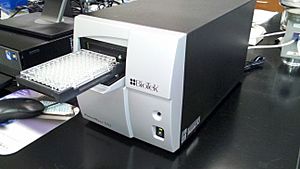Plate reader facts for kids
Microplate readers are cool laboratory machines. They help scientists see tiny changes in special trays called microtiter plates. These changes can be about living things, chemicals, or how things move and work.
How Do Plate Readers Work?
Most of the time, a very bright light shines onto the small cups (called wells) in a microtiter plate. Inside these wells, chemicals react in special ways. The plate reader then measures these reactions.
Plate readers can measure different things, like:
- How much light a chemical soaks up.
- If a chemical starts to glow (this is called fluorescence).
- How long a certain chemical reaction takes to finish.
Today, many plate readers also come with tools that help scientists understand all the information they collect.
What Are Plate Readers Used For?
Plate readers are super useful tools! Scientists use them for many things, such as:
- Watching how cells grow.
- Measuring how much acid is in different chemicals.
- Seeing how cells react to new things.
- Checking how active Enzymes are (enzymes are like tiny helpers for chemical reactions).
- Finding out if something is harmful to cells.
- Measuring the amounts of different chemicals inside cells.
- Testing new substances to see if they could become medicines.
Using these machines helps scientists do their work much faster and more accurately. Plate readers are mostly used in research, like when scientists are trying to discover new medicines. They also help check how pure chemicals are in pharmacies and other labs.
Related Pages
See also
 In Spanish: Lector de placas para niños
In Spanish: Lector de placas para niños


